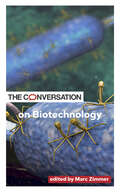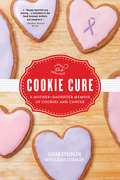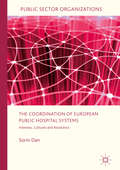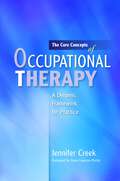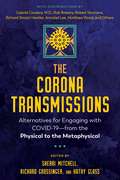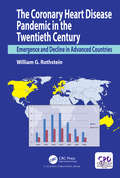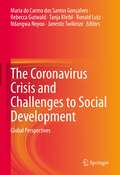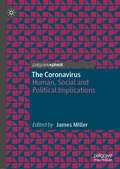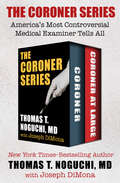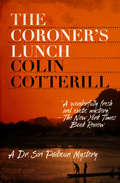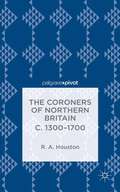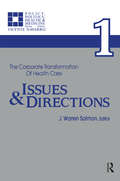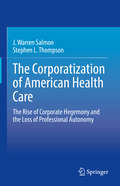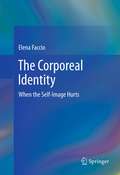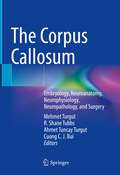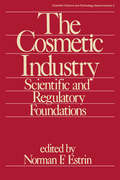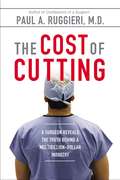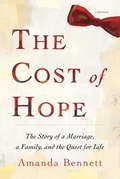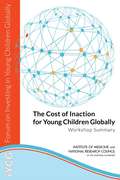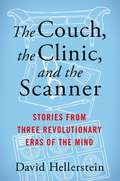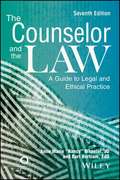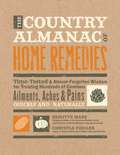- Table View
- List View
The Conversation on Biotechnology (Critical Conversations)
by Marc ZimmerFrom the contributors to The Conversation, this collection of essays by leading experts in biotechnology provides foundational knowledge on a range of topics, from CRISPR gene sequencing to the ethics of GMOs and "designer babies."In The Conversation on Biotechnology, editor Marc Zimmer collects essays from The Conversation U.S. by top scholars and experts in the field, who present a primer on the latest biotechnology research, the overwhelming possibilities it offers, and the risks of its abuse. From an overview of CRISPR technology and gene editing in GMOs to the ethical questions surrounding "designer babies" and other applications of biotechnology in humans, it highlights the major implications biotechnology will bring for health and society. Topics range from the spectacular use of light to fire individual neurons in the brain to making plant-based meats; from curbing diseases with genetically modified mosquitoes to looking back on 40 years of opinions on IVF babies.The Critical Conversations series collects essays from top scholars on timely topics, including water, biotechnology, gender diversity, gun culture, and more, originally published on the independent news site The Conversation U.S.Contributors: Nathan Ahlgren, Ivan Anishchenko, Trine Antonsen, Jennifer Barfield, Pedro Belda-Ferre, Ari Berkowitz, Adeline Boettcher, Jason Delbourne, Kevin Doxzen, Mo Ebrahimkhani, Eleanor Feingold, J. Benjamin Hurlbut, Cecile Janssens, Samira Kiani, Amanda Kowalczyk, Mariana Lamas, Andrew Lapworth, Rebecca Mackelprang, Kathleen Merrigan, Saman Naghieh, Sean Nee, Dimitri Perrin, Christopher Preston, Jason Rasgon, Penny Riggs, Jason Robert, Oliver Rogoyski, Gary Samore, Sahotra Sarkar, George E. Seidel, Patricia A. Stapleton, Craig W. Stevens, Paul B. Thompson, Christopher Tuggle, Vikramaditya G. Yadav, Marc Zimmer
The Cookie Cure: A Mother-Daughter Memoir
by Susan Stachler Laura StachlerA heartwarming memoir of a family that refused to give upWhen twenty-two-year-old Susan Stachler was diagnosed with cancer, her mother, Laura, was struck by déjà vu: the same illness that took her sister's life was threatening to take her daughter's too. Heartbroken but steadfast, Laura pledged to help Susan through the worst of her treatments. When they discovered that Laura's homemade ginger cookies soothed the side effects of Susan's chemo, the mother-daughter duo soon found themselves opening Susansnaps and sharing their gourmet gingersnaps with the world. Told with admirable grace and infinite hope, The Cookie Cure is about more than baked goods and cancer—it's about fighting for your life and for your dreams.
The Coordination of European Public Hospital Systems
by Sorin DanThis book engages theoretically and empirically with the unprecedented wave of public management reforms in public hospitals in Europe in the past 25 years. It provides a useful overview of these reforms and studies the way in which they have influenced the ability of national policy-making institutions to co-ordinate the system of public hospitals as a whole. Using a comparative structure, as well as original empirical data collected by the author, the book examines case studies on which little has so far been published for an international audience in English.
The Core Concepts of Occupational Therapy
by Jennifer CreekThe profession of occupational therapy has a highly specialised language, but until now there have been no standard definitions of its key terms. Based on the work of the terminology project group of the European Network of Occupational Therapy in Higher Education (ENOTHE), this book selects and defines the core building blocks of occupational therapy theory. Consensus definitions of a wide range of terms are developed through an analysis of published definitions from around the world. Concepts with similar meanings are clustered into groups, and the clusters are then arranged into a conceptual map. The book provides an analysis of what each term means in common usage, how it is used in occupational therapy, and its implications for therapeutic practice. The conceptual framework that emerges represents an important contribution to the profession's understanding of the fundamental concepts of occupational therapy. The consensus definitions presented in this book will facilitate communication between professionals as well as with clients and others, and will be of interest to occupational therapy practitioners, students, educators and researchers.
The Corona Transmissions: Alternatives for Engaging with COVID-19—from the Physical to the Metaphysical
by Sherri Mitchell, Richard Grossinger and Kathy Glass• Includes contributions from 35 well-known authors, doctors, herbalists, First Nations teachers, economists, astrologers, and others, such as Richard Strozzi-Heckler, Annabel Lee, Matthew Wood, Gabriel Cousens, M.D., Rob Brezsny, and Robert Simmons • All royalties for this book go to the Land Peace foundation, serving First Nations tribes in Maine The pandemic of Coronavirus Disease 2019 (COVID-19) is the biggest event of our lifetimes. This global experience has affected human history, ecology, epidemiology, and supply chains with the suddenness of 9/11, yet with a far greater extent, duration, and toll--the end of which is not yet in sight. Exploring a broad spectrum of new perspectives on COVID-19, from the physical to the metaphysical, from ecological to political, from apocalyptic to proto-utopian, and from scientific facts and health tips to imaginings, visionings, poems, and awakenings, this anthology offers an antidote to the barrage of data and speculation from the mainstream. The 35 contributors, including Laura Aversano, Charles Eisenstein, Zoe Brezsny, Meryl Nass, M.D., Bobby Byrd, and Joel and Michelle Levey, address the virus as a fellow being, allowing it to speak to us and through us. They attempt to describe, understand, interpret, and decipher the virus at biological, serological, epidemiological, social, political, astrological, and ontological levels. The virus is explored in terms of cultural critique, divination, prophecy, warning, elucidation, and opportunity. Medical doctors, herbalists, naturopaths, indigenous healers, and homeopathic physicians tell us about coronavirus history, treatments, and prevention protocols; yoga teachers about cultivating inner balance and harmony; and economists, poets, psychotherapists, and First Nations teachers about the vast effects of the virus and the way forward. They explore how the disease speaks directly and how it meticulously addresses our relationship to Gaia, to its animal, plant, and mineral kingdoms, to each other, and to the economies and dystopia we have created. As a visionary whole, The Corona Transmissions asks you to respond, to engage your wisdom and creative imagination, to resist easy categorization and resolutions, and to participate in a collective dance and chant for healing, peace, equality, and a habitable future. Viruses do not live except by virtue of us carrying them. We are the living ones and our bodies, minds, hearts, and spirits will prevail.
The Coronary Heart Disease Pandemic in the Twentieth Century: Emergence and Decline in Advanced Countries
by William G. RothsteinThis book demonstrates that a pandemic of coronary heart disease occurred in North America, western and northern Europe, and Australia and New Zealand from the 1930s to about 2000. At its peak it caused more deaths than any other disease. The book examines and compares trends in coronary heart disease mortality rates for individual countries. The most detailed analyses are for the United States, where mortality rates are examined for race, sex, and age groups and for geographic regions. Popular explanations for the rise and fall of coronary heart disease mortality rates are examined.
The Coronavirus Crisis and Challenges to Social Development: Global Perspectives
by Rebecca Gutwald Tanja Kleibl Ronald Lutz Ndangwa Noyoo Maria do Carmo dos Santos Gonçalves Janestic TwikirizeThis book is a novel contribution to academic discourses on the coronavirus (COVID-19) crisis and how it has impacted societies globally. It proffers an overview on the social development and political measures, from both the Global North and Global South, to prevent COVID-19's spread. It illuminates major social, political and economic challenges that already existed in different contexts and which are also currently being amplified by COVID-19. Curiously, this global pandemic has opened spaces for different actors, across the globe, to begin to fundamentally question and challenge the hegemony of the Global North, which sometimes is evident in social work. Linked to the foregoing and while reflecting beyond the pandemic and into the future, the book proposes that social work must become more political at all levels, and strive to transform societies, global social development efforts, and economic and health systems. This contributed volume of 38 chapters discusses and analyses ethical, social, sociological, social work and social development issues that complement and enrich available literature in the socio-political, economics, public health, medical ethics and political science. It provides various case studies which should enable readers to gain insights into how countries have responded to the pandemic and learn how COVID-19 negatively impacted countries in different parts of the world. This book also provides a platform for the articulation of neglected and marginalized voices, such as those of indigenous populations, the poor, or oppressed. The chapters are grouped according to three main themes as they relate to research on the COVID-19 pandemic and social work in Africa, Asia, Europe, Latin America and North America:Analysis: Social Issues and the COVID-19 Pandemic Strategies and Responses in Social Work: Globally and LocallyOutlook: Looking Ahead Beyond the PandemicIntended to engage a global, diverse and interdisciplinary audience, The Coronavirus Crisis and Challenges to Social Development is a timely and relevant resource for academics, students and researchers in inter alia Social Work, Philosophy, Sociology, Economics, and Development Studies.
The Coronavirus: Human, Social and Political Implications
by James MillerThis book describes and analyzes the impact of COVID-19 on the relationship between the United States and China in its human, social and political dimensions. It does so through the experience of faculty and students at Duke University and Duke Kunshan University, a US-China joint venture university. The book reveals the intimate stories of Chinese people trapped in quarantine, situating these stories in a longer historical perspective of plagues and disease prevention in China. It describes the impact of the virus on the racialized perceptions of Chinese-Americans and Chinese students in America. Finally, it offers a preliminary assessment of the impact of the coronavirus on the legitimacy of the Chinese Communist Party, and on US-China relations. Featuring the work of artists, student journalists, historians, anthropologists and political scientists, this book presents a breadth of insights into the impact of COVID-19.
The Coroner Series: America's Most Controversial Medical Examiner Tells All (Coroner)
by Thomas T. Noguchi Joseph DiMonaA New York Times–bestselling author and renowned Los Angeles medical examiner challenges the verdicts in America&’s most controversial celebrity deaths. &“Dr. Thomas T. Noguchi encountered the best and the worst of Los Angeles—movie stars and gangsters, politicians and millionaires. . . . But by the time &‘the coroner to the stars&’ met them, they were on his autopsy table&” (Los Angeles Times). In his New York Times–bestselling autobiography and its fascinating follow-up—now together in a single volume—Dr. Noguchi recounts his stormy career, divulges his innovative techniques, and reveals the full story behind his most intriguing investigations. Coroner: Dr. Noguchi sheds light on his most controversial cases: the suspicious drowning death of Natalie Wood, Marilyn Monroe&’s suicide, the assassination of Robert Kennedy, the circumstances behind the drug-related deaths of Janis Joplin and John Belushi, the murder of Sharon Tate. and more. Coroner at Large: Often called the &“Detective of Death,&” Dr. Noguchi continues to probe the most famous fatalities in recent pop-culture history: the drowning of Beach Boy Dennis Wilson, the Hollywood murder of Sal Mineo, the suicide of Freddie Prinze, the slaying of &“Playmate of the Year&” Dorothy Stratten, Elvis Presley&’s final hours, and more. Noguchi&’s forensic acumen also provides new clues to the fates of such historical figures as Gen. George Custer, Napoleon, and Adolf Hitler. In both riveting accounts, Dr. Noguchi documents his own investigations and pioneering work in the field, as the mysteries of death—natural and unnatural—are unraveled by &“one of the greats of modern forensic pathology&” (Barry A. J. Fisher, director of the Los Angeles County sheriff&’s crime lab).
The Coroner's Lunch
by Colin CotterillDr. Siri Paiboun, one of the last doctors left in Laos after the communist takeover, has been drafted to be national coroner. He is untrained for the job, but this independent seventy-two-year-old has an outstanding qualification for it: curiosity. And he doesn't mind incurring the wrath of the Party hierarchy as he unravels mysterious murders, because the spirits of the dead are on his side. With the help of his newly appointed secretary, the ambitious and shrewd Dtui, and Mr. Geung, the Down syndrome-afflicted morgue assistant, Dr. Paiboun performs autopsies and begins asking questions to solve the mysteries relating to the death of the wife of a government official and of the unidentified body fished out of the river--a body that was not drowned, but tortured with electricity. As it turns out, all is not peaceful and calm in the new communist paradise of Laos.
The Coroner's Lunch
by Colin CotterillDr. Siri Paiboun, one of the last doctors left in Laos after the communist takeover, has been drafted to be national coroner. He is untrained for the job, but this independent seventy-two-year-old has an outstanding qualification for it: curiosity. And he doesn't mind incurring the wrath of the Party hierarchy as he unravels mysterious murders, because the spirits of the dead are on his side. With the help of his newly appointed secretary, the ambitious and shrewd Dtui, and Mr. Geung, the Down syndrome-afflicted morgue assistant, Dr. Paiboun performs autopsies and begins asking questions to solve the mysteries relating to the death of the wife of a government official and of the unidentified body fished out of the river--a body that was not drowned, but tortured with electricity. As it turns out, all is not peaceful and calm in the new communist paradise of Laos.
The Coroner's Lunch
by Colin CotterillDr. Siri Paiboun, one of the last doctors left in Laos after the Communist takeover, has been drafted to be national coroner. He is untrained for the job, but this independent 72-year-old has an outstanding qualification for it: curiosity. And he doesn't mind incurring the wrath of the Party hierarchy as he unravels mysterious murders, because the spirits of the dead are on his side. With the help of his newly-appointed secretary, the ambitious and shrewd Dtui, and Mr. Geung, the Down-Syndrome-afflicted morgue assistant, Dr. Paiboun performs autopsies and begins asking questions to solve the mysteries relating to the death of the wife of a government official and of the unidentified body fished out of the river who didn't drown but was tortured with electricity. As it turns out, all is not peaceful and calm in the new Communist paradise of Laos.
The Coroners of Northern Britain c. 1300–1700
by R. A. HoustonFor the last 800 years coroners have been important in England's legal and political landscape, best known as investigators of sudden, suspicious, or unexplained death. Against the background of the coroner's role in historic England, this book explains how sudden death was investigated by magistrates in Scotland.
The Corporate Transformation of Health Care: Part 1: Issues and Directions (Policy, Politics, Health and Medicine Series)
by Warren J SalmonThe author explores how the corporate transformation of hospitals, HMOs, and the insurance and pharmaceutical industries has resulted in reduction in services, dangerous cost cutting, poor regulation, and corrupt research. He sheds light on the political lobbying and media manipulation that keeps the present system in place. Exposing the shortcomings of reform proposals that do little to alter the status quo, he makes a case for a workable single-payer system. This is an essential read for today's practitioners, policy makers, healthcare analysts and providers, and all those concerned with the precarious state of America's under- and uninsured.
The Corporatization of American Health Care: The Rise of Corporate Hegemony and the Loss of Professional Autonomy
by J. Warren Salmon Stephen L. ThompsonIn this book, the authors, as policy analysts, examine the overall context and dynamics of modern medicine, focusing on the changing conditions of medical practice through the lens of corporatization of medicine, physician unionization, physician strikes, and current health policy directions. Conditions affecting the American medical profession have been dramatically altered by the continuing crises of cost increases, quality concerns, and lack of access facing our population, along with the ongoing corporatization toward bottom-line dictates. Pressures on practitioners have been intensifying with much greater scrutiny over their clinical decision-making. Topics explored among the chapters include:History of the Corporatization of American Medicine: The Market Paradigm ReignsPharmaceuticals, Hospitals, Nursing Homes, Drug Store Chains, and Pharmacy Benefit Manager/Insurer IntegrationMedical Practice: From Cottage Industry to Corporate PracticeMedical Malpractice Crisis: Oversight of the Practice of MedicineBig Data: Information Technology as Control over the Profession of MedicinePhysician Employment Status: Collective Bargaining and StrikesThe Corporatization of American Health Care offers different perspectives with the hopes that physicians will unite in a new awareness and common cause to curtail excessive profit-making, renew professional altruism, restore the charitable impulse to health provider institutions, and unite with other professionals to truly raise levels of population health and the quality of health care. It is also a necessary resource for health policy analysts, healthcare administrators, health law attorneys, and other associated health professions.
The Corporeal Identity
by Elena FaccioExplorees the cultural origins and psychological aspects of body identity disorders. Discusses the influence of contemporary virtual and cyberspace imagery on self-image. Draws on author's professional experience largely dedicated to exploring disorders wherein body identity is the chosen field for communication and exchange. Re-examines such illnesses as anorexia, bulimia, body dysmorphic disorder, and others
The Corpus Callosum: Embryology, Neuroanatomy, Neurophysiology, Neuropathology, and Surgery
by Ahmet Tuncay Turgut R. Shane Tubbs Mehmet Turgut Cuong C. J. BuiThis book provides an in-depth review of knowledge of the corpus callosum, called white matter or terra incognita, with emphasis on anatomical, embryological, diagnostics, and surgical features. It includes very informative chapters from leaders in the field, organized into six main groups: first, the embryology, neuroanatomy, and morphometry of the corpus callosum, and animal studies related to it; secondly, neurophysiological aspects, callosal disconnection and the split brain; thirdly, neuropathology, including clinical disorders such as dementia, Tourette syndrome, and schizophrenia; fourthly, surgical procedures including partial and complete callosotomy and commissurotomy; fifthly, cognitive neuroscience; and sixthly, other features of the corpus callosum, including its medicolegal aspects and statistical shape analysis. This comprehensive reference book will be an ideal source for neuroscientists at all levels, from graduate students to researchers in specific disciplines studying this region including neuroanatomists, embryologists, neurosurgeons, neurologists, neuroradiologists and pediatricians, who seek both basic and more advanced information regarding the distinctive anatomical, physiological and pathological features of the human corpus callosum.
The Cosmetic Industry: Norman F. (Cosmetic Science And Technology Ser.)
by EstrinThis book summarizes the authority of regulatory agencies and programs as they pertain to the cosmetic industry, offers practical advice on how to operate within the regulatory environment, and introduces scientific and regulatory issues that are likely to have an impact on cosmetic manufacturers. "This interesting volume reports all the novel technologies in use to study and control the cosmetic products in order to make them effective and free of side effects." ---Journal of Applied Cosmetology, 2000
The Cost of Cutting
by Paul A. RuggieriWhy is surgery so expensive? Surgeon Paul A. Ruggieri reveals little-known truths about his profession--and the hidden flaws of our healthcare system--in this compelling and troubling account of real patients, real doctors, and how money influences medical decisions behind the scenes. Even many well-informed patients have no idea what may be contributing to the cost of their surgery. With up-to-date research and stories from his practice, Ruggieri shows how business arrangements among hospitals, insurance companies, and surgeons affect who gets treatment--and whether they get the right treatment. Pulling back the curtain from the hospital bed, he explains how to safeguard one's own health (and finances), and how America can make surgery more affordable for all without sacrificing quality care.
The Cost of Hope
by Amanda BennettFrom Pulitzer Prize winner Amanda Bennett comes a moving, eye-opening, and beautifully written memoir--a love story of two unusual people, their complex marriage and deep devotion, and finally, Bennett's quest to save her husband's life. When Wall Street Journal reporter Amanda Bennett meets the eccentric, infuriating, yet somehow irresistible Terence Bryan Foley while on assignment in China, the last thing she expects is to marry him. They are so different--classic and bohemian, bow ties and batik, quirky and sensible. But Terence is persistent. "You are going to be somebody," he tells her. "You're going to need somebody to take care of you." Though initially as combative as their courtship, their marriage brings with it stormy passion, deep love and respect, two beloved children, and a life together over two decades. Then comes illness, and the fight to win a longer life for Terence. The Cost of Hope chronicles the extraordinary measures Amanda and Terence take to preserve not only Terence's life but also the life of their family. After his death, Bennett uses her skills as a veteran investigative reporter to determine the cost of their mission of hope. What she discovers raises important questions many people face, and vital issues about the intricacies of America's healthcare system. Rich in humor, insight, and candor, The Cost of Hope is an unforgettable memoir, an inspiring personal story that sheds light on one of the most important turning points in life.From the Hardcover edition.
The Cost of Inaction for Young Children Globally: Workshop Summary
by Kimber Bogard"The Cost of Inaction for Young Children Globally" is the summary of a workshop hosted by the Institute of Medicine Forum on Investing in Young Children Globally in April 2014 to focus on investments in young children and the cost of inaction. Participants explored existing, new, and innovative science and research from around the world to translate this evidence into sound and strategic investments in policies and practices that will make a difference in the lives of children and their caregivers. This report discusses intersections across health, education, nutrition, living conditions, and social protection and how investments of economic, natural, social, and other resources can sustain or promote early childhood development and well-being.
The Couch, the Clinic, and the Scanner: Stories from Three Revolutionary Eras of the Mind
by David HellersteinOver the past several decades, psychiatry has undergone radical changes. After its midcentury heyday, psychoanalysis gave way to a worldview guided by the Diagnostic and Statistical Manual, which precisely defined mental disorders and their treatments; more recently, this too has been displaced by a model inspired by neuroscience. Each of these three dominant models overturned the previous era’s assumptions, methods, treatment options, and goals. Each has its own definitions of health and disease, its own concepts of the mind. And each has offered clinicians and patients new possibilities as well as pitfalls.The Couch, the Clinic, and the Scanner is an insightful first-person account of psychiatry’s evolution. David Hellerstein—a psychiatrist who has practiced in New York City since the early 1980s, working with patients, doing research, and helping run clinics and hospitals—provides a window into how the profession has transformed. In vivid stories and essays, he explores the lived experience of psychiatric work and the daunting challenges of healing the mind amid ever-changing theoretical models. Recounting his intellectual, clinical, and personal adventures, Hellerstein finds unexpected poetry in hallways and waiting rooms; encounters with patients who are by turns baffling, frustrating, and inspiring; and the advances of science. Drawing on narrative-medicine approaches, The Couch, the Clinic, and the Scanner offers a perceptive and eloquent portrayal of the practice of psychiatry as it has struggled to define and redefine itself.
The Counselor and the Law: A Guide to Legal and Ethical Practice (6th Edition)
by Anne Marie Wheeler Burt BertramAttorney Wheeler, who has experience with counselors and the mental health field, and Bertram, a counselor, marriage and family therapist, and counselor educator, help counselors and other mental health professionals understand the legal and ethical dilemmas that can arise in practice. They overview the counseling profession, counseling relationship, and law and ethics, and discuss federal and state laws; civil malpractice liability and licensure board complaints; confidentiality, privilege, and privacy; duties to report, warn, or protect; suicide and threats of harm to self; professional boundaries; records and documentation; and managing the counseling practice. This edition has a new chapter on the use of social media and other Internet-related issues, updates to the Health Insurance Portability and Accountability Act (HIPAA) through the Health Information Technology for Economic and Clinical Health (HITECH) Act and regulations, a new legal/ethical decision-making model, and discussion of legal risks for counselor educators, such as recent court cases involving students' work with lesbian, gay, bisexual, and transgender clients.
The Counselor and the Law: A Guide to Legal and Ethical Practice (Seventh Edition)
by Anne Marie Wheeler Burt BertramIn this seventh edition of The Counselor and the Law, each chapter has been updated to reflect changes in the 2014 ACA Code of Ethics, findings of recent court cases, and new federal and state legislation. Attorney Nancy Wheeler and Burt Bertram, a private practitioner and counselor educator, provide a comprehensive overview of the law as it pertains to counseling practice; an in-depth look at counselors legal and ethical responsibilities; and an array of risk management strategies. Written in a clear and engaging style, this text is not only a widely used and respected resource for students, it also provides real answers for clinicians who are challenged daily to act in the best interest of their clients while minimizing the chances of becoming involved in an ethical or legal complaint. The issues surrounding civil malpractice liability, licensure board complaints, confidentiality, duty to warn, suicide and threats of harm to self, professional boundaries, records and documentation, and managing a counseling practice are addressed in detail.
The Country Almanac of Home Remedies: Time-Tested and Almost Forgotten Wisdom for Treating Hundreds of Common Ailments, Aches and Pains Quickly and Naturally
by Chrystle Fiedler Brigitte MarsNatural Wisdom for Curing Every Ache, Pain, and Ailment As little as a few decades ago, folk remedies were a part of everyday life. More often than not, our grandparents would go to their garden or kitchen pantry before they went to a doctor to treat everyday health complaints. Today, scientific studies are proving what Grandma knew all along--natural remedies are oftentimes just as effective as modern cures, have fewer side-effects, and cost just pennies. Moreover, natural remedies have stood the test of time. Peppermint has been used as soothe upset stomachs long before Pepto-Bismal and ginger has been used for its antibiotic properties for thousands of years in Asian medicine. Learn how to quickly and naturally treat over 100 common conditions with everyday cures: -Use Apple Cider Vinegar and Honey to break up congestion -Black or Green Teabags will take the sting out of a bad sunburn -Drink Beet, Celery, and Cucumber juice to soothe a shingles outbreak. -Inhale oil of Geranium to calm a hot flash -Apply a Witch Hazel compress to treat varicose veins -Pumpkin Seeds improve male potency -Burnt Toast soaks up internal toxins -Epsom Salt bathes heal the lymphatic system Filled with thousands of surprising cures, each entry gives multiple remedies for each condition from herbs, to healing foods, to acupressure and yoga poses. Hundreds of step-by-step illustrations show you the right way to administer a treatment from making herbal tinctures to applying a poultice. Dosage guidelines are given for every remedy as well as safety guidelines, contraindications, and when to call a doctor.
